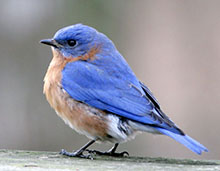Bluebirds struggle on island paradise

University of Groningen ecologist Kevin Matson made the cover of the scientific journal Physiological and Biochemical Zoology with his study of Bermudian bluebirds. His work shows the vulnerability of this iconic island species, which graces the two-dollar note in Bermuda.
‘This project was a follow-up from my PhD project, which compared island and continental birds more generally’, Matson explains. He wanted to better understand the differences between the ordinary bluebird living on the American continent and the island population.
Other researchers have used genetics to show the island population was established just a few hundred generations ago, which is not very long in term of evolutionary time. Yet Matson showed the birds on Bermuda are lighter weight than their continental cousins and have longer wings. ‘That’s peculiar because island birds are typically larger than continental counterparts and would be expected to have shorter wings.’
He also found increased mortality of island bluebird chicks. ‘That may be caused by seasonal dry spells, but recently introduced predators like feral cats and recently introduced competitors like house sparrows may also play a role. Furthermore, the use of insecticides may affect the birds’ diet.’
Matson’s advice to Bermudans is to counteract chick mortality by providing and maintaining nest boxes. ‘That’s been done in America when bluebirds were on the decline, and it worked well.’ A press release covering the project resulted in an article in the Bermudian newspaper The Royal Gazette. ‘That was really my aim in seeking publicity for my paper. The Bermudans care a lot about their bluebirds, so I wanted them to hear about my work.’
In Groningen, where Matson has worked since 2006 (and where he got a NWO Veni grant in 2008), his focus is now on homing pigeons. ‘I have a flock in the Linnaeusborg aviary, which I study as a comparison for work done in the field. With fieldwork, you often only get small windows of time for sampling each year, but my pigeons can be studied and sampled regularly throughout the year.’
Matson aims to combine fieldwork and lab work. ‘That is the style of the group I work in, led by Irene Tieleman, and it is a style that really suits me. Fieldwork is exciting, but lab work is stimulating as well It gives you the opportunity to work out more details on physiology.’
Reference
K.D. Matson, R.A. Mauck, S.E. Lynn, and B.I. Tieleman, “Island Life Shapes the Physiology and Life History of Eastern Bluebirds (Sialia sialis),” Physiological and Biochemical Zoology 87(1), January/February 2014.
More information Bluebirds Struggle to Find Happiness on Island Paradise
| Last modified: | 10 February 2017 3.11 p.m. |
More news
-
15 April 2024
Single-molecule engineering niche in Gravitation research
With her expertise in single-molecule techniques, Dr. Kasia Tych (GBB) will contribute to a big Grvitation-research programme
-
15 April 2024
Night vision with artificial atoms
Every two weeks, UG Makers puts the spotlight on a researcher who has created something tangible, ranging from homemade measuring equipment for academic research to small or larger products that can change our daily lives. That is how UG...
-
09 April 2024
University of Groningen to become member of the 4TU Stan Ackermans Institute
Through this membership, the two EngD programmes in Autonomous Systems and in Sustainable Process Design at the Faculty of Science and Engineering will be added to this partnership with the 4TU from September 2024
